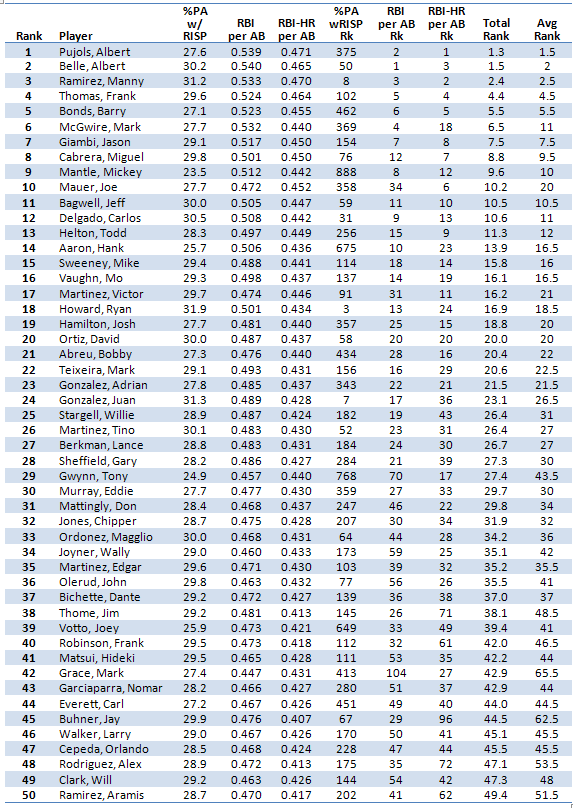A common and legitimate criticism of using RBI as a measure of a hitter’s effectiveness is that RBI are opportunity-based and, therefore, good RBI totals may simply be an indicator of more RBI opportunities. To address this limitation in raw RBI totals, this post looks at players who are most proficient in driving in runs when they are presented with that opportunity (namely, when runners are in scoring position).
Using this approach, Albert Pujols, Albert Belle and Manny Ramirez emerge as the most proficient expansion era run producers with RISP, with Frank Thomas just a hair behind.
My thanks to regular HHS contributor Richard Chester for suggesting the idea for this post. More after the jump.
This study looks at player performance in RISP situations since 1961, a period for which PBP data are nearly 100% complete. Evaluated are the 1026 players (incl. active players) with 3000 PA (through Aug 27th) in the period. Their PAs with RISP range from a low of 18.7% (Horace Clark) to a high of 32.6% (Bob Watson).
Using PBP data for these RISP PAs yields the following average RBI rates per AB. Note that only RBI produced in RISP PAs are counted, not all RBI. I’ve presented RBI per AB instead of RBI per PA because players who walk (or are walked) frequently in these situations would be disadvantaged by a per PA metric, and probably unfairly so.
That’s a .073 run difference per AB between the top and bottom of this list. But that difference will add up, to over 7 runs per year, based on a conservative estimate of 100 RISP ABs in an average season. Also bear in mind that this is just the top 5% of players, so the difference between the leaders and the average player will be greater still.
Notable that most of these players are of recent vintage, an indication that, looking only at RISP situations goes only part of the way in normalizing data. What’s missing are normalization for park effects, run scoring environment, batting order position, and the like. Some notes:
- Mickey Mantle does very well to make the top 10 based only on data for the back end of his career.
- Note Dante Bichette, one of sabermetric’s favorite whipping boys, finishing ahead of teammate and sabermetric darling Larry Walker (but only by a bit).
- Is Mike Sweeney baseball’s best pinch-hitter of the past half century? Well he would be if he was Mark Sweeney and those were his numbers (thanks to RJ for spotting my goof). This Sweeney is the Royal catcher turned first baseman who went .324/.396/.535 with 432 RBI for 1999-2002. Hands up if you knew Mike had a 144 RBI season.
The second set of metrics are for the quantity RBI-HR, or RDI (Runners Driven In), chosen to try to level the playing field between power hitters and others. Again, results are presented per AB.
Still .05 of a run difference per AB between top and bottom of this list, so about 5 runs per year based on 100 RISP ABs, and more when compared to the average player.
Note that this approach only partly achieves the objective of normalizing between home run hitters and others. The power guys still benefit by driving in runners from all bases (not just those in scoring position) and doing so regardless of the baserunning abilities of those runners. That is a good segue into the obvious caveat that not all RISP opportunities are created equally, even for comparable hitters. Thus, I’d put my money on Freddie Patek driving in Willie Wilson from second over, say, Mark Belanger doing the same with Brooks Robinson on base.
Some thoughts on this list:
- Players not known for their power nonetheless show well here, especially high-average types like Tony Gwynn and Nomar Garciaparra.
- Players with better BAs and a bit of pop also make an appearance, like Bobby Abreu, Kirby Puckett, Mark Grace, Moises Alou and Rico Carty.
- Some surprises. Anybody pick Carl Everett or Mike Hargrove?
Combining the two results, each player is assigned a ranking for RBI and RBI-HR, with the harmonized mean of those rankings presented as a Total Rank, and Average Rank being just that, the average of the two rankings. The harmonized mean, calculated as twice the product of the ranks divided by their sum, has the effect of basing the Total Rank more on the metric in which a player did better, whereas the Average Rank weights each metric equally. Shown below are the top 50 by Total Rank.
Some thoughts on the rankings.
- People discount Ryan Howard‘s RBI totals because he gets a lot of RBI opportunities. Well, they’re right about the latter point as Howard ranks 3rd in % of PA w/RISP. But, Howard makes the top 25 in both of our metrics, so he is doing something right.
- Big differences in rankings for the two metrics for some of these players, particularly Mark Grace (focus on making contact) and Jay Buhner (focus on going yard).
- Others have very similar rankings, particularly the top of the list plus David Ortiz, Adrian Gonzalez, Eddie Murray, Dante Bichette, Chipper Jones and Orlando Cepeda.
- Would anybody have guessed Mickey Mantle would make the bottom 15% of players in % of PA with RISP? Yes, the Yankees were awful his last 3 years, but they were AL champs for half of the seasons represented here.
Didn’t see your favorite player? Not to worry. Data for all 1026 players in the study are available here.
As a follow-up to this post, I’ll compare these results with RE24 performance in the same RISP situations.



